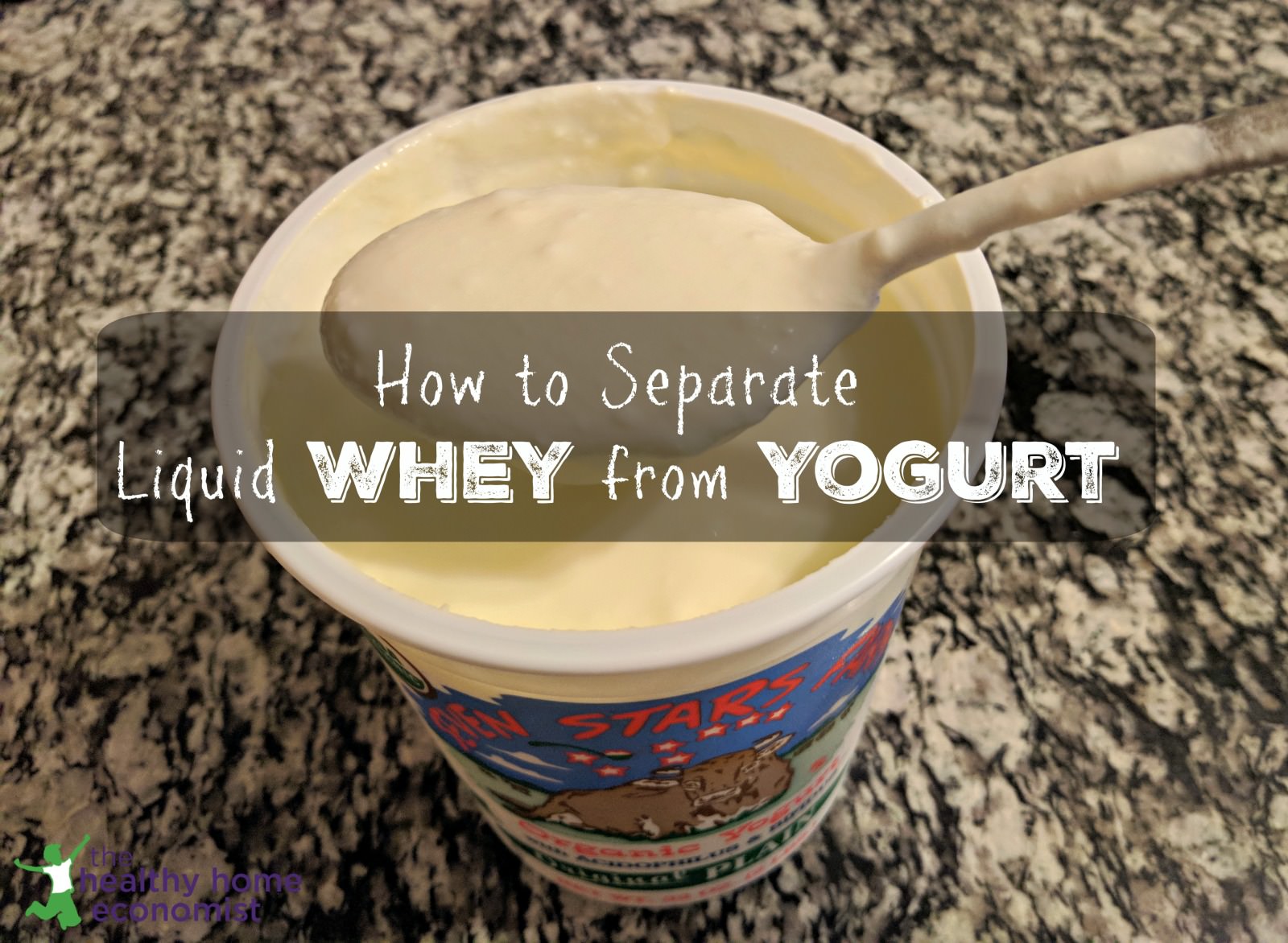Table of Contents[Hide][Show]
 Whey in its liquid and whole food form is the ideal starter for probiotic-rich, health-enhancing fermented foods and drinks.
Whey in its liquid and whole food form is the ideal starter for probiotic-rich, health-enhancing fermented foods and drinks.
Liquid whey is most easily and economically obtained from soured raw milk also called clabbered milk.
Clabbered milk is a very useful item for the traditionally minded cook and has the consistency and taste of drinkable style yogurt.
Unfortunately, not everyone has access to raw milk which may seem to preclude the use of unprocessed, liquid whey for fermentation purposes as it is not commercially available.
The good news is that you can easily extract whey from plain yogurt from the store. Using homemade yogurt is even better. You may use Greek yogurt too although you won’t get as much whey from the effort. This is due to the nutritional differences of Greek yogurt vs regular yogurt.
Powdered Whey No Substitute for the Real Thing
Please note that powdered whey is never an adequate substitute for whole, unprocessed, liquid whey. To gain the benefits of whey, it must be gently separated from a fermented dairy product like clabbered milk, kefir, or yogurt.
Drying and powderizing whey even at low temperatures denature the delicate proteins. It also eliminates the beneficial probiotic and enzymatic properties.
Uses for Liquid Whey
Liquid whey is an important ingredient in homemade baby formula recipes. In addition, it is indispensable as an inoculant for fermented foods and drinks. Unprocessed liquid whey is also wonderful to mix with filtered water and a little orange juice for a healthy sports drink naturally loaded with electrolytes.
How to Separate Whey from Yogurt (or Kefir)
The easy recipe below will result in a jar of beautiful raw whey within minutes! You won’t believe how easy it is! I recommend that you do not use Greek yogurt, as it contains significantly less whey than regular yogurt.
I also recommend that you stick with quality yogurt brands as there is quite a bit of variation within the industry.

How to Separate Whey from Yogurt
Simple how-to for separating whey from yogurt or kefir. Homemade or store bought brands may be used including whole, lowfat, and no fat versions. Whole yogurt is recommended, however.
Ingredients
- 1 quart plain yogurt kefir may be substituted
- 1 large glass bowl
- 1 fine mesh cheese cloth
- 1 large rubber band
Instructions
-
Line bowl with cheesecloth. Spoon in the container of yogurt.
-
Gather up the ends of the cheesecloth and secure with the rubber band. Attach the rubber band to a knob on one of your upper kitchen cabinets. Keep the bowl beneath to catch the dripping whey.
-
Leave dripping on the counter for about 1 hour.
-
Remove drip bag from the kitchen knob and place in a clean bowl. Unfasten the rubber band and scrape out the yogurt cheese within the cheesecloth into a container. Seal the lid and refrigerate.
-
Pour the liquid whey in the first bowl into a glass mason jar and secure the lid. Refrigerate. It will stay fresh for several months.
Separating Whey from Yogurt (Video Tutorial)
In the video below, I show you the very easy process for obtaining whey in its liquid, whole food form from a quart of plain yogurt. I also discuss what to do with the leftover yogurt cheese once the whey has been extracted. Hint: it makes a delicious stuffing for large pasta shells or lasagna.
Note that you can use kefir in place of yogurt if desired. Use the exact same process shown in the video. Kefir is healthier than yogurt too, containing far more beneficial probiotics. Unfortunately, it is harder to find quality brands commercially, but fortunately, kefir is easier to make at home than yogurt if that’s what you’d really prefer to use.
If using yogurt, you are going to want to source the best quality your budget can afford. Ideally, this is grass-fed organic whole yogurt. But, in a pinch, you can use no fat or low-fat yogurt from supermarket brands like Dannon.
Cloudy or clear liquid whey will last in a glass mason jar in the refrigerator for about six months. Note, however, that the flavor will grow stronger and more pungent over time.








Thank you for the info how to separate whey from yogurt! Happy Holidays! Kim
Hi Sarah,
I often make my own cottage cheese by boiling, then simmering whole milk with lemon juice, and straining out the whey. I was wondering if that whey is usable for lacto-fermentation as well, or if the heating process somehow makes it less desirable than the method you’ve shown.
Thank you!
Unfortunately, cooked whey leftover from the cheesemaking process is not useful for lacto-fermentation or making homemade baby formula. It makes great fertilizer in the garden though!
I have made whey from raw milk and have looked at various ways of using it. I am interested in learning how did our forefathers make the first starters for their yogurts ect. We have today the ability to buy commercial products. I want to know how they did it in the old days. So I would like to know the origins of the cultures for yogurt, cream cheese, sour cream ect. Is whey made from clabbering milk suitable to make each of these products or do you need different cultures and if so, how would you make them if you did not have commercially available forms. Any references to books would also be helpful.
Thank you.
I am making whey from some whole milk plain yogurt that I had bought. This is my first time, and I am noticing that the whey is a lot more milky looking than Sarah’s whey in the video. The yogurt is more runnier than other yogurts, and am wondering if some of it is straining thru? Sarah, or anyone with experience, am I able to use my cloudy whey for the orangina, and other fermented recipes, or do I need to find a thicker yogurt?! Any advice would be appreciated. Thank you! – Alicia
Alicia, you can strain the whey again to get a more clear end product. Also, make sure you’re using a tightly-woven cloth or similar product to do the straining. When I strain yogurt, I use either coffee filters or flour-sack towels, inside a strainer suspended over a glass bowl. I don’t think the thinness or thickness of the yogurt matters except maybe in how much whey you’ll get from the strained yogurt.
Can I use full fat goat yogurt?
If making yogurt from dry milk powder can the whey be used as a starter ? Roughly how much whey to make a qt. of yogurt >
Thanks
KinA
I understand that powdered protein may not be a substitute, but isn’t powdered yogurt whey completely different than powdered protein? I would assume that drying and powdering a yogurt whey is not the same.
Nearly impossible to get plain yogurt. Will the whey from store buttermilk work? What about the whey from milk kefir?
Can you just had liquid whey to smoothies for health reasons. My kids don’t like fermented foods but I want to find a way to sneak it in. Will this work?
Kelly, yes you can add liquid whey to smoothies; it gives it a little bit of a tang depending on what else you put in. You don’t need much; just a spoonful per serving.
Hi Sarah what do you think of the “No Whey camp” There are some who advocate against whey with vegetable based ferments?